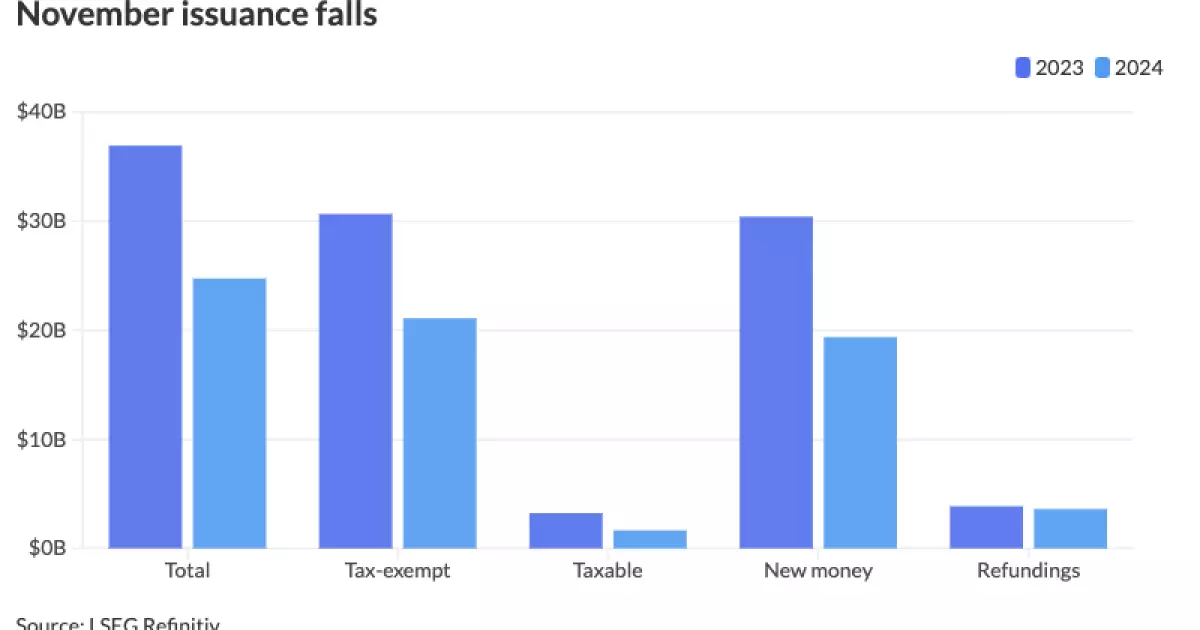In November 2024, the municipal bond market experienced a notable decline in issuance, marking the first drop in year-over-year volume for the year. Reportedly, the total issuance dropped to $24.743 billion across 607 separate issues, representing a significant 33% decrease compared to the $36.918 billion across 822 issues recorded in November 2023. This reduction not only indicates the smallest monthly total for 2024 but also falls below the historical 10-year average of $32.278 billion. This decline can largely be attributed to two key factors: the uncertainty surrounding the recent elections and the limited number of available pricing days throughout the month.
Despite this apparent downturn during November, the overall municipal bond issuance for the year is on track to shatter previous records. As of November’s end, the year-to-date volume had reached $474.755 billion—up an impressive 32.8% year-over-year—putting the market on a trajectory to potentially surpass the $500 billion mark by year’s end. Experts predict that December alone could add between $20 billion and $30 billion to this total, possibly helping to achieve a year-end record.
Factors Influencing the Decrease
According to Tom Kozlik, the head of public policy and municipal strategy for HilltopSecurities, the lack of available pricing days in November played a crucial role in the diminished issuance figures. Significant events such as the election and meetings of the Federal Open Market Committee created interruptions in market activity. The Thanksgiving holiday further truncated the available window for issuers, resulting in a concentrated flurry of activity that was unable to make up for the losses earlier in the month. Chad Farrington from DWS echoed this sentiment, noting that the weeks surrounding the election and holiday period saw drastically reduced issuance numbers.
In addition to calendar-related factors, election-related market volatility has contributed to the cautious approach among issuers. Prior to the elections, issuance rates surged as market participants sought to act before the potential for uncertainty. However, post-election volatility has not significantly disrupted the municipal market. There’s a shift in uncertainty from election outcomes to policy implications, with concerns lingering about what changes might lie ahead.
Future of Tax-Exempt Bonds
It’s essential to consider the impending threats to tax-exempt bonds as a significant backdrop to the current market landscape. While recent trends indicate a lack of waning enthusiasm from issuers, potential changes in tax legislation loom large on the horizon. Kozlik suggests that proposed changes to tax policies could severely affect the issuance of tax-exempt bonds, possibly triggering a rush of issuance activity in the coming months as municipalities aim to secure these financial instruments before potential legislative changes. This brings to mind the chaotic December of 2017 when the Tax Cuts and Jobs Act led to a surge in issuance as municipalities hurried to issue tax-exempt bonds before new regulations came into force.
Conversely, other strategists express skepticism about how imminent these changes might be and their eventual impact on issuance levels. Matt Fabian of Municipal Market Analytics warns that the early removal of tax exemptions or a potential recalibration of exemption values could drastically lower issuance figures to between $250 billion and $300 billion—a stark contrast to the $500 billion consensus among market participants.
Amid the broader trends in the municipal bond market, certain states have been leading contributors to the overall issuance success in 2024. California remains at the forefront, accounting for $68.902 billion in issuance, followed closely by Texas and New York. Interestingly, some states, such as Florida and Pennsylvania, show remarkable year-over-year growth rates in issuance, suggesting regional variations in market activity.
Although November’s issuance reflects a downturn, the year’s overall performance indicates a thriving municipal bond market heading towards record levels. Upcoming months will likely depend on several intersecting factors, including legislative developments, market volatility, and issuer confidence. The municipal bond landscape remains dynamic, shaped by both immediate conditions and anticipated shifts in policy, ensuring ongoing interest and scrutiny from market participants. As the industry moves into December and contemplates 2025, the interplay of these elements will critically inform the evolution of municipal bond issuance in the near future.


Leave a Reply